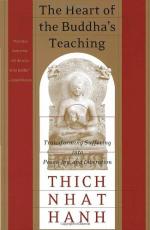
|
| Name: _________________________ | Period: ___________________ |
This test consists of 15 multiple choice questions and 5 short answer questions.
Multiple Choice Questions
1. Energy is the result of what?
(a) Feeling meaning in our lives.
(b) Love.
(c) Compassion.
(d) Hope.
2. The Sarvastivada school defined how many conditions?
(a) Three.
(b) Two.
(c) Five.
(d) Four.
3. We can look deeply into the Five Aggregates, and remember the reality of what?
(a) No-birth and no-death.
(b) Birth and death.
(c) Life.
(d) Joy and suffering.
4. What does form include?
(a) Our emotions.
(b) Our body.
(c) Our body and five sense organs.
(d) Our five senses.
5. Each element of the Noble Eightfold Path is contained where?
(a) In categories.
(b) Individually.
(c) Within the others.
(d) In small groups.
6. What is the second of the Five Faculties?
(a) Insight or wisdom.
(b) Diligence.
(c) Faith in something reliable.
(d) Mindfulness.
7. The Five Faculties are powers that can help us do what?
(a) Understand paradise.
(b) Accept the present.
(c) Generate the energy in ourselves to be in paradise.
(d) Find paradise.
8. Mindfulness, investigation of phenomena, diligence, joy, ease, concentration and letting go are the seven factors of what?
(a) The Four Noble Truths.
(b) Awakening or enlightenment.
(c) Sangha.
(d) The Wheel of Dharma.
9. What isthe third of the Five Faculties?
(a) Mindfulness.
(b) Diligence.
(c) Faith in something reliable.
(d) Insight or wisdom.
10. Looking beyond signs means what?
(a) Looking to Buddha for advice.
(b) Not looking toward fate.
(c) Making one's own decisions.
(d) Losing fear of losing specific manifestations.
11. Incorrect perceptions are conditioned by the afflictions in us of what?
(a) Crazing, hatred, anger, and pain.
(b) Ignorance, craving, hatred, anger, and jealousy.
(c) Fear, hurt, pain, and uncertainty.
(d) Ignorance, fear, hurt, and pain.
12. Hanh suggests meditating mindfully on what parts of the body?
(a) The inner parts.
(b) Each part.
(c) The outer parts.
(d) The organs.
13. Hanh asks us to practice transformation by what?
(a) Deep thinking and deep meditation.
(b) Deep thinking and deep action.
(c) Deep meditation and deep passion.
(d) Deep looking and deep touching.
14. Why is life span an illusion?
(a) No one's life span is the same.
(b) We have never been born and we never die.
(c) No one knows his or her life span.
(d) A human life span is longer.
15. Like the relationship of a plant and the earth, when we take refuge in Buddha, ______________________.
(a) Buddha takes pride in us.
(b) Buddha takes refuge in us.
(c) Buddha remembers us.
(d) Buddha encourages us to take refuge in the self.
Short Answer Questions
1. What is signlessness?
2. What are the three jewels of refuge in Buddhism?
3. What must we realize about everything?
4. Our anger or despair is connected to what?
5. Finding a way to earn a living that does not conflict with love and compassion can do what?
|
This section contains 497 words (approx. 2 pages at 300 words per page) |

|




